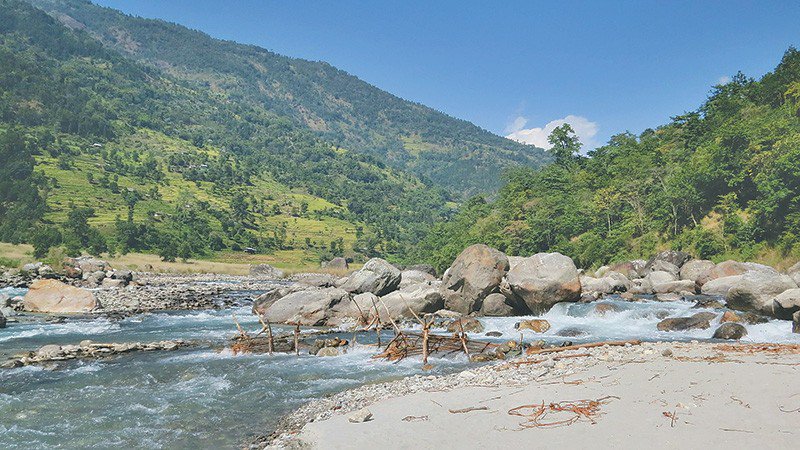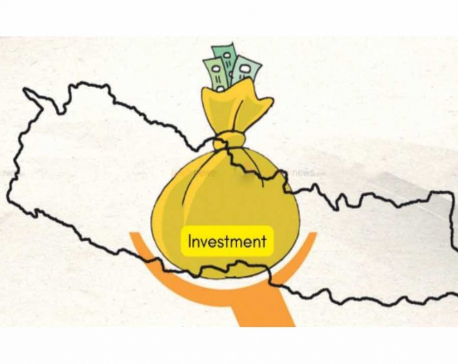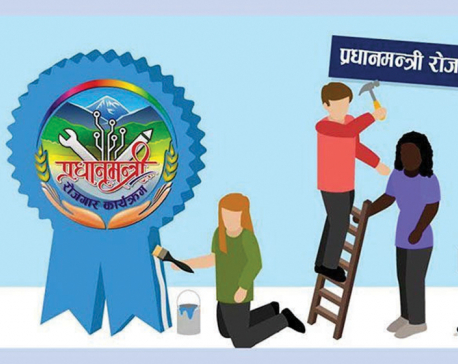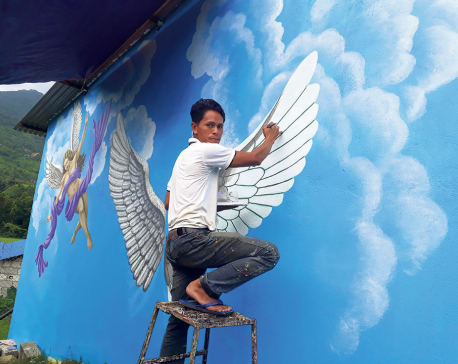
OR
Opinion
Tamor Storage Hydro Project: A game changer for Eastern Nepal
Published On: December 25, 2022 09:40 AM NPT By: KUSHAL BASNET

KUSHAL BASNET
The author is a Civil Engineer who graduated from Pulchowk Campus.news@myrepublica.com
More from Author
Nepal has a huge hydropower potential. The perennial nature of rivers and the steep gradient of the country’s topography provide ideal conditions for the development of some of the world’s largest hydropower projects in Nepal. Current estimates are that Nepal has approximately 42,000 MW of economically feasible hydropower potential. However, in the present context, the total installed capacity is 2010 MW in the Integrated Nepal Power System.
Although bestowed with tremendous hydropower resources, only about 50% of Nepal’s population has access to electricity. Nepal’s electricity generation is dominated by hydropower, though in an entire scenario of energy use of the country, electricity is a tiny fraction. The bulk of energy needs is dominated by wood and imported fossil fuel. With this scenario and having immense potential for hydropower development, it is important for Nepal to increase its energy dependence on electricity with hydropower development. It is also essential to increase national income through energy exports which will help to reduce poverty and increase employment opportunities.
Importance of Storage Project
Most of the power plants in Nepal are run-of-river type with energy available in excess during the monsoon season and deficit during dry season.Therefore, there is a clear need to develop storage type hydropower projects to generate much needed electricity in the dry season with an added benefit of increased provision of irrigation for agriculture production. Nepal has only two storage projects named Kulekhani I (60 MW) & Kulekhani II (32 MW) due to which we are forced to import electricity from India during the dry season to meet domestic demands. Run-of-river operates in high capacity during the season of heavy rainfall and melting of snow, thus limiting its capacity during the dry season, ultimately creating power shortage during the dry season.
On the other hand, storage-type projects have much greater potential for social and environmental impact than the run-of-river projects. Since, there are only two storage type projects, the Government of Nepal should focus on developing mega projects on storage type. There are some proposed storage projects for development such as Tamor (762 MW), Dudhkoshi (635 MW), Budigandaki (1200 MW), Nalsingad (410 MW) and West Seti (750 MW) in different parts of the country.
Importance of Tamor Storage Project
Tamor Storage Hydropower Project is located on Tamor River at a Latitude of 27°03'11.9"N and Longitude of 87°32'56.5"E in the border of Panchthar and Terhathum district of Province 1. It is located about 650 km east from Kathmandu and the project area can be accessed by Mechi Highway from Jhapa, Puspalal Highway from Panchthar and Tamor Corridor from Dharan to Taplejung.
The Tamor River basin is situated in Eastern Nepal, with its origin in the Himalayas (Mt Kanchanjunga) and flows to form the Saptakoshi River which mixes with the Ganga River (Ganges) in India and ultimately reaches the Indian Ocean. Most of the precipitation is concentrated during the monsoon season. Also, snow-covered mountains and glaciers in the upper reaches of the basin supply melting water to the streamflow throughout the year. Moreover, small tributaries like Kabeli, Hewa, Sewa and Koya rivers provide considerable perennial water discharge in the basin.
The basin has a very diverse climate since the elevation ranges from 350 m to 7526 m above the sea level within 150 km length. The south-east monsoon is the most dominant climatic influence. As in other parts of Nepal, Tamor River also experiences the effects of the Southwest monsoon season, which on average lasts from June till the end of September.
In terms of hydrology and geology, there are two hydrological stations of the Department of Hydrology and Meteorology (DHM), namely station number 684: Majhitar and 690: Mulghat. It covers a catchment area of 5094 sq km. The average flow of the river is 310 m3/s and the design flow of the project is 657.4 m3/s. As per the regional geology, thrusts were identified upstream and downstream of the proposed headworks and powerhouse location. No major geological structure was identified during the survey.
Initially, the project was identified by Japan International Cooperation Agency (JICA) in 1985, which had proposed building 696 MW by building a 153-meter high dam. However, the government did not show much interest in the proposal at that time. Since 2013, Nepal Electricity Authority (NEA) has been studying to build the project of 762 MW by erecting a 210 meters dam that will be constructed at Lumbuwaghat, a border area between Panchthar and Tehrathum districts.
Currently, the project has been awarded to a Nepal-China joint venture company. In 2019, the Investment Board Nepal (IBN) called for a proposal for foreign investment in the project. In response to IBN’s call, Power China Corporation and Hydropower Investment and Development Company Limited (HIDCL), a company owned by Nepal Government jointly proposed to develop the project. As no other proposal was received, the project was awarded to Nepal China JV.
Conclusion
For the eastern province, Tamor High-dam project can be a game changer project for reducing dependency of electricity from other provinces and also serve as a means to achieve prosperity for the people through employment opportunities. A preliminary report prepared by NEA indicates that the geographical location, social impact assessment and environmental conditions are feasible to build the storage project in the area. But the main obstacle to the project is two upstream hydropower projects, namely 37.5 MW Kabeli ‘A’ which is under construction and 21.5 MW Lower Hewakhola which has been generating electricity since April 2017. There is a possibility that these projects will be submerged.
Having high water level in the river to meet the electricity generation output will increase the flow of water of its tributaries - Kabeli and Hewa Khola. Therefore, the Tamor Project needs to compensate the promoters of these small projects for if it wants to successfully complete the mega project
As project development cost is not very high and the scale of social and environmental impact is lower, it is essential to consider the larger national interest which can turn around the fate of the eastern region by completing the 762 MW capacity project. The development of reservoir-based hydropower projects is also important to trade electricity with India and Bangladesh as such projects can generate power consistently which is not the case for run-of-river hydropower projects. The necessary funds can be obtained under the leadership of Province 1 government adopting different alternatives like requesting financial assistance, soft loans from foreign agencies, public shares and provincial budget allocation which can turn around the fate of our province.
The best option will be to construct the project by Nepal or Province 1 government itself with their own investment and own manpower instead of awarding it to foreign companies but the technology required can be imported for the overall benefit of people in this region. The generated power can be exported to either India or Bangladesh from the transmission line that will be constructed from the project site to Inaruwa via Kakarbhitta border, whose cost of construction will also be lower as well since the distance from the project to the nearby market is considerably less. Hence, the economic and social conditions of people in this region will be drastically improved by energy trade between neighboring countries or generated power can be utilized within the country for various industrial and domestic purposes.
Salient Features Tamor Reservoir Project
Diversion– Three Inverted D type diversion tunnel of 11 m diameter with average length of 1.5 km carrying diversion discharge of 1667.67 m3/s per tunnel. An earthen coffer dam around 70 m height to divert the water.
v Dam – A 210m high Rock fill type dam with impervious clay core storage. The crest elevation of the dam is 558 mean sea level and the crest length is around 550 m. A gate controlled chute type spillway will be situated at elevation of 530 mean sea level.
v Reservoir- Full Supply Level=550 m
Minimum water level=492 m
Dead storage level=475 m
v Intake – Four number of sloping intake with minimum operating level of 492 m is proposed.
v Waterway-
Headrace Tunnel: 6.5 m diameter around 1 km long four inverted D type headrace tunnel.
Vertical Shaft: Around 130m long four vertical drop shaft
Penstock Pipe: Four penstock pipe of average length 100m and diameter 6 m is proposed.
v Power House- An underground power station, 150m downstream of toe of the dam.
v Turbine- Four 194 MW rated Vertical Axis Francis Turbine with
Gross head=198 m, Net head=169.73 m, Rated Discharge= 129.75 m3/s
Centre line of Turbine=347 m & Tail water level= 352 m
v Tailrace- 8 m diameter Inverted D type tailrace tunnel discharging the flow back to Tamor River.
v Energy Generation-The Powerhouse operates for 6 hour in dry season whereas 24 hour operation is proposed for wet season.
Annual Electricity Generation =3353.85 GWh
Wet Season=2248.1 GWh & Dry Season =1105.75 GWh
v Power Evacuation- As proposed from NEA study, generated power to be carried by 400 KV double circuit transmission line to proposed substation at Inaruwa, Sunsari district which is around 75 km long.
(Source: NEA Study report)
You May Like This

Investing in Nepal for a Noble Cause
Nepal, a nation endowed with abundant natural resources and cultural richness, has traversed through turbulent times marred by poverty and... Read More...

Govt allocates Rs 6 billion to employ 60,000 individuals
KATHMANDU, Dec 13: At a time when unemployment is rising in the country, the government is going to spend about... Read More...

Prosperity through Art
PARBAT, Sept 26: Different organizations -- government and non-government -- conduct vocational training intended at developing skills of the youths.... Read More...










Just In
- NRB introduces cautiously flexible measures to address ongoing slowdown in various economic sectors
- Forced Covid-19 cremations: is it too late for redemption?
- NRB to provide collateral-free loans to foreign employment seekers
- NEB to publish Grade 12 results next week
- Body handover begins; Relatives remain dissatisfied with insurance, compensation amount
- NC defers its plan to join Koshi govt
- NRB to review microfinance loan interest rate
- 134 dead in floods and landslides since onset of monsoon this year








Leave A Comment